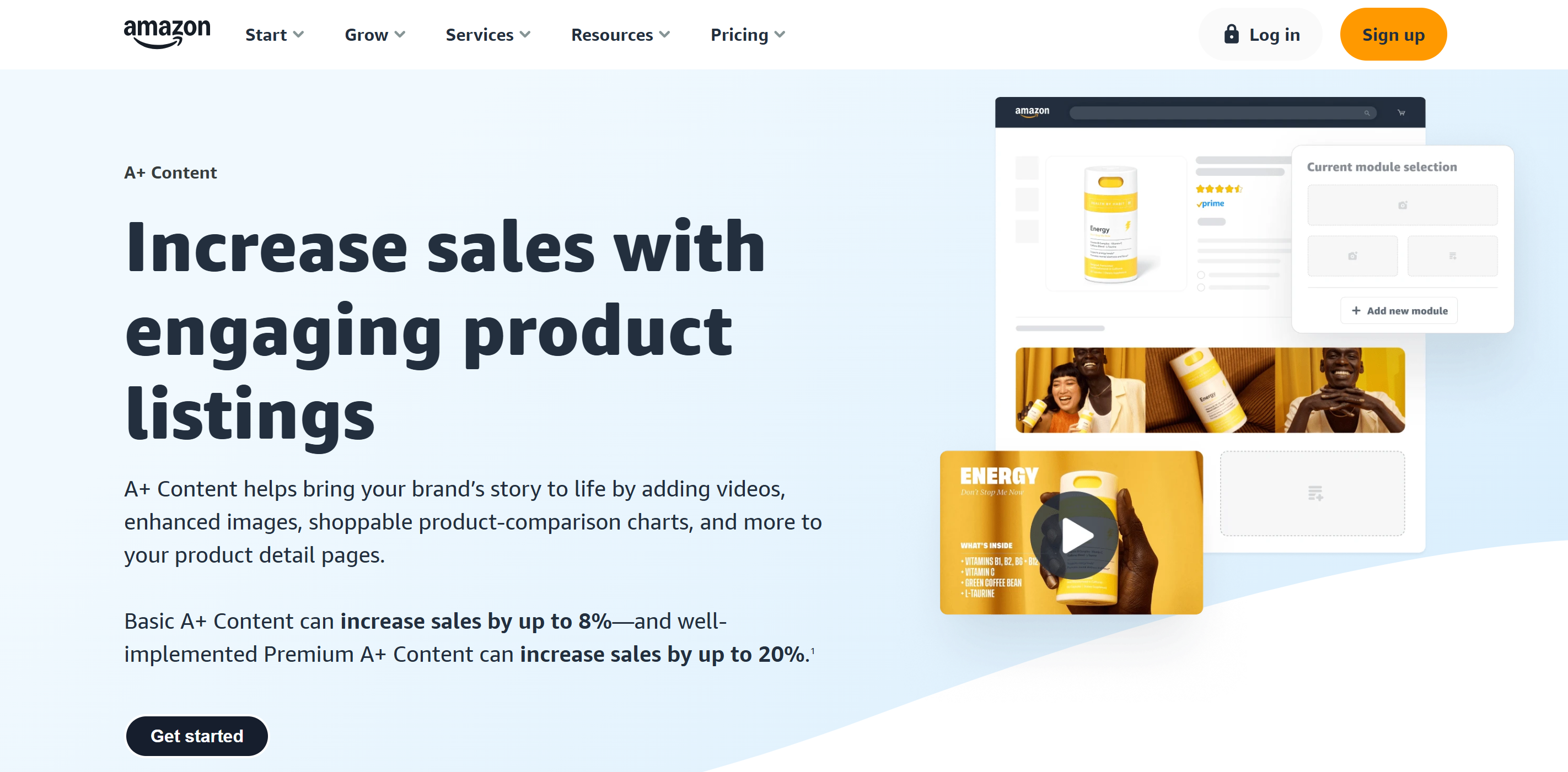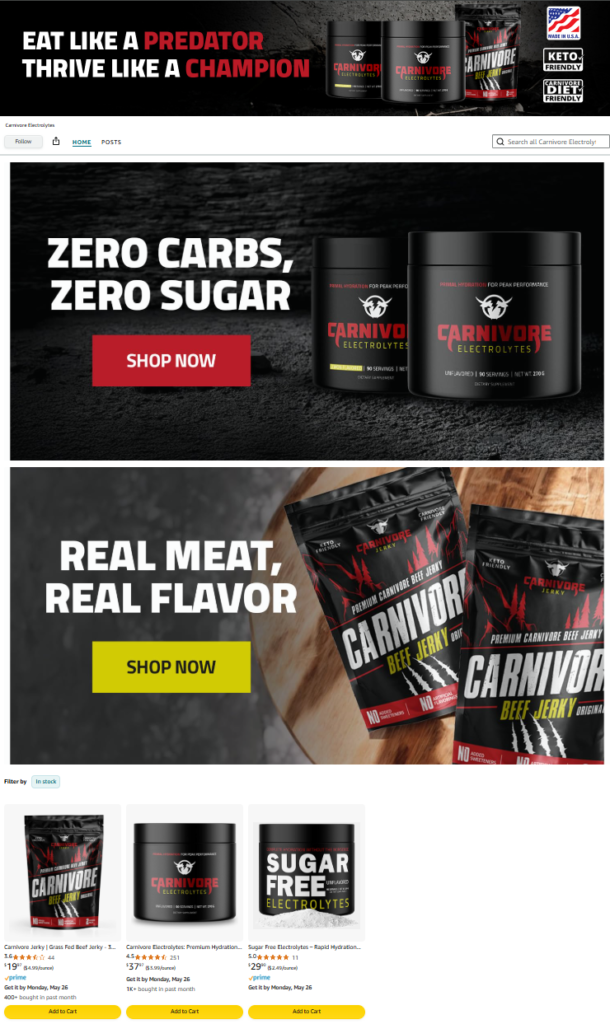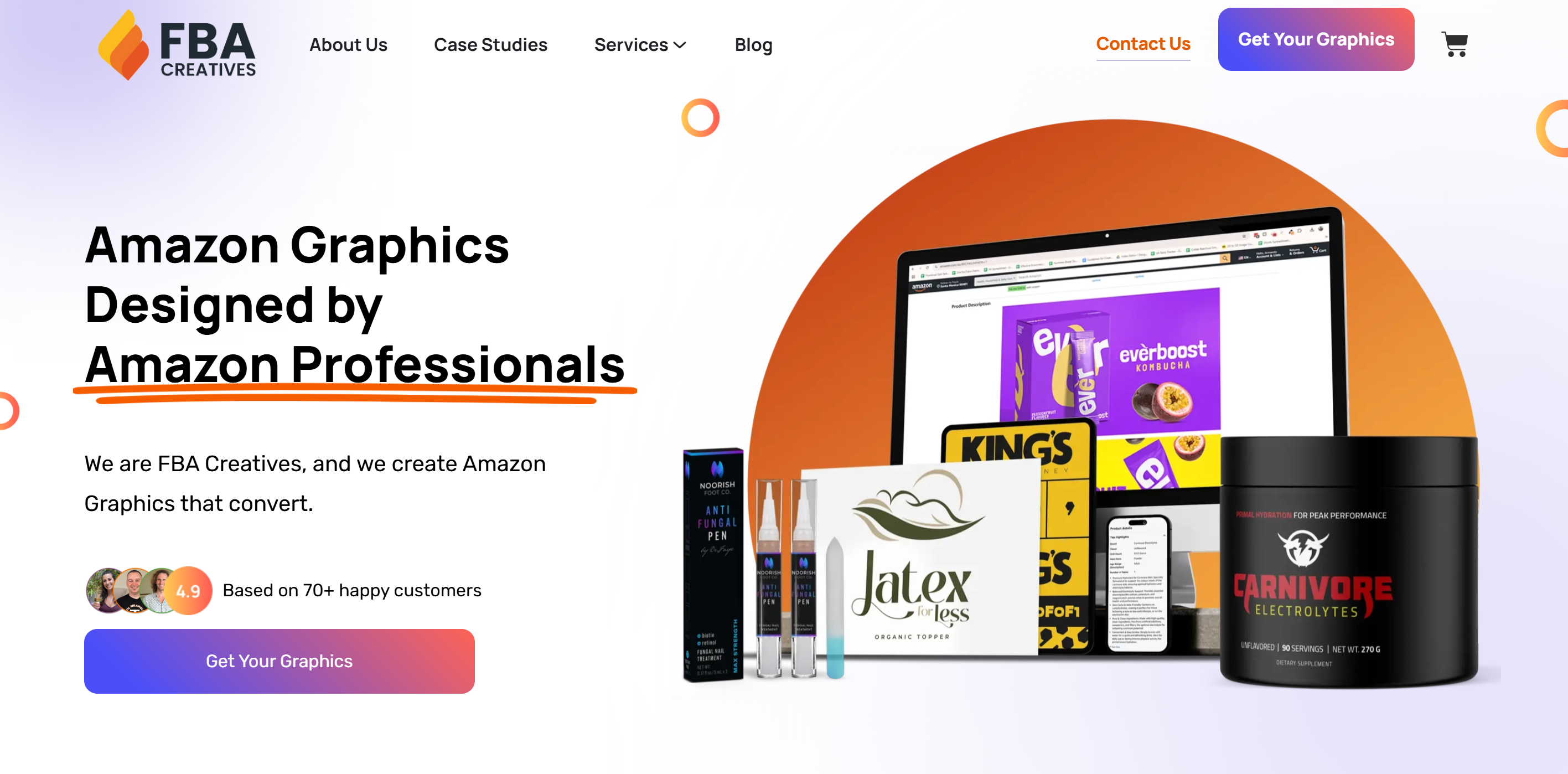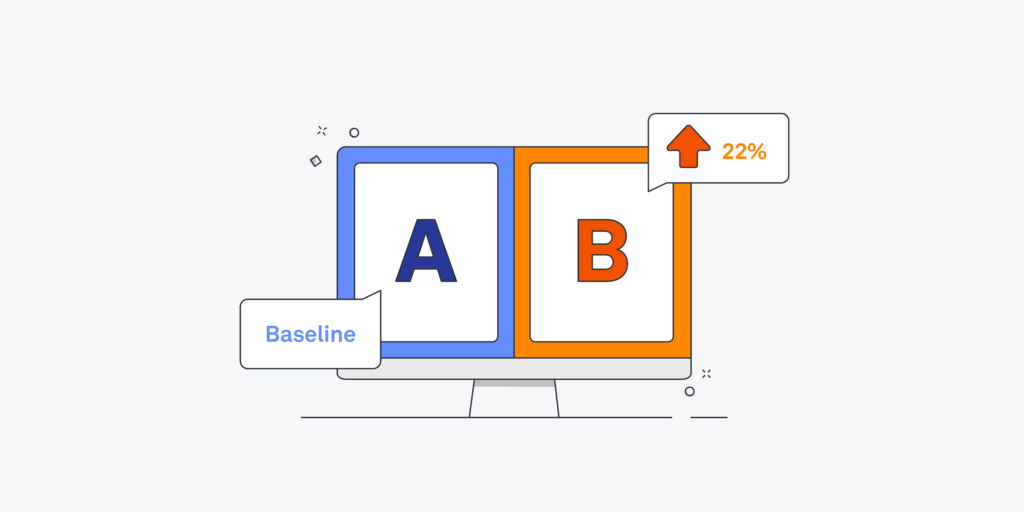
Learn how Amazon A+ Content Boosts Sales & Builds Your Brand In 2025
Tips That Actually WorK
Selling on Amazon is no longer as simple as listing a product and waiting for orders to roll in. With millions of listings competing for attention, success now depends on how well you present your brand and convey value. This is where Amazon A+ Content becomes a powerful game-changer.
Amazon A+ Content allows sellers to enhance their product detail pages with rich visuals, engaging copy, and structured layouts. By moving beyond the limitations of standard descriptions and bullet points, A+ Content enables you to tell your brand story in a more compelling way—ultimately leading to higher conversions, stronger customer trust, and increased sales.
In this guide, you’ll discover exactly how Amazon A+ Content can transform your listings and why it should be a priority in your growth strategy. Whether you’re just starting or aiming to optimize established listings, this article will provide practical, expert-backed insights to help you leverage A+ Content effectively.
- What Is Amazon A+ Content?
- Why Amazon Introduced A+ Content
- The Psychology Behind Amazon's Algorithm and Conversion
- Tangible Benefits of Amazon A+ Content
- Key Elements of High-Impact A+ Content
- Amazon A+ Content vs. Standard Listings
- Examples of Winning A+ Content Layouts
- How A+ Content Fits Into a Larger Brand Strategy
- DIY vs. Hiring Professionals: What You Need to Know
- Common Mistakes to Avoid with A+ Content
- FULL Amazon A+ Content Guideline List
- Measuring the Success of Your A+ Content
- Scaling With Premium A+ Content (A++ Modules)
- Future of A+ Content on Amazon
- Maximize Your Potential with A+ Content
- FAQ's
What Is Amazon A+ Content?

Amazon A+ Content is a feature that allows brand-registered sellers to enhance their product listings with rich, multimedia content. Instead of relying solely on basic product descriptions and bullet points, sellers can now use A+ Content to create immersive product pages that include high-quality images, engaging text, comparison charts, and even lifestyle visuals.
There are two main levels of Amazon A+ Content:
- Basic A+ Content: This is available to all sellers enrolled in the Amazon Brand Registry. It includes a variety of standard modules like text-and-image blocks, feature callouts, and Q&A sections. These modules help you better explain your product features, showcase benefits, and differentiate from competitors.
- Premium A+ Content (A++): This level is typically available by invitation only, usually to vendors or top-performing brands. It includes more advanced features such as interactive modules, carousels, hover effects, embedded videos, and enhanced comparison charts.
To access A+ Content, you must be enrolled in Amazon Brand Registry. Once enrolled, you can begin creating A+ pages from your Seller Central dashboard. This enhanced content is displayed in the product detail section, usually just below the bullet points and above customer reviews.
A+ Content not only helps clarify your product offering but also reinforces your brand identity—making it a strategic asset for long-term success.
Why Amazon Introduced A+ Content
Amazon developed A+ Content to address a key pain point: standard listings often fail to provide enough information or brand presence to persuade today’s savvy shoppers. With so many options available, consumers need more than just a list of features—they need visual storytelling, trust signals, and reasons to believe in your product.
That’s exactly what A+ Content delivers. It empowers sellers to turn static, text-heavy listings into dynamic, visually compelling experiences. This kind of enhanced presentation enables buyers to understand your product more deeply, reducing confusion and increasing confidence in the purchase.
Moreover, Amazon benefits too. When customers are better informed, they’re more likely to make a purchase and less likely to return the item. This win-win situation is why Amazon continues to prioritize enhanced content as part of its evolving eCommerce experience.
By incorporating modules like product highlights, lifestyle imagery, and comparison tables, A+ Content also allows brands to answer common questions up front—streamlining the buyer journey and removing objections before they arise. This translates to smoother conversions and happier customers.
The Psychology Behind Amazon’s Algorithm and Conversion

To truly understand the power of Amazon A+ Content, it’s important to look at how customers make purchasing decisions. Online shoppers, especially on a platform like Amazon, make split-second judgments based on visual cues. If your product page lacks emotional appeal or fails to communicate value quickly, customers may scroll past—even if your product is exactly what they need.
This is where the psychology of A+ Content becomes especially relevant. When you add high-quality images, organized layouts, and persuasive storytelling, you reduce the mental load placed on shoppers. Instead of piecing together information from scattered bullet points, they receive a cohesive narrative that’s easy to absorb.
Visual hierarchy also plays a critical role. Strategic placement of benefits, icons, and testimonials helps guide the shopper’s eye and reinforces key selling points. This builds trust, communicates professionalism, and encourages a stronger emotional connection.
In short, A+ Content works because it’s aligned with how people process information and make decisions. By delivering content in a structured, visually rich format, you not only inform but also influence—leading to higher conversions and better customer satisfaction.
Tangible Benefits of Amazon A+ Content

While A+ Content is visually appealing, its real value lies in measurable performance improvements. Sellers who implement A+ Content consistently report significant boosts in conversion rates—often by 5% to 10%, and in some cases, even higher.
Here are some of the most impactful benefits:
- Higher Conversion Rates: When shoppers better understand your product, they’re more likely to click “Add to Cart.” A+ Content makes your listings more persuasive, which directly leads to increased sales.
- Reduced Return Rates: A well-informed customer is a happy customer. By using visual comparisons, technical specifications, and lifestyle use cases, A+ Content sets clear expectations. This helps buyers make the right choice the first time—reducing post-purchase regret and returns.
- Stronger Brand Perception: Consistent and polished A+ layouts reinforce your professionalism and credibility. When your product pages look premium, customers assume your product quality is too.
- Better Customer Retention: Shoppers who connect with your brand through engaging visuals and storytelling are more likely to remember you—and return to buy again.
Ultimately, Amazon A+ Content helps you shift from being just another seller to becoming a brand that customers trust and prefer. And in a marketplace driven by reviews, ratings, and impressions, that distinction is invaluable.
Key Elements of High-Impact A+ Content

Not all A+ Content is created equal. To truly maximize results, you must design with intention. The most effective A+ Content doesn’t just look good—it communicates clearly, aligns with your customer’s needs, and supports your overall brand strategy.
Here are the key elements that define high-performing A+ Content:
- Infographics That Simplify Complexity: Use diagrams and callouts to break down complicated features into bite-sized, easy-to-understand visuals. This is especially useful for tech or multifunctional products.
- Comparison Charts: Highlight the advantages of your product versus similar items—either from your own catalog or general market alternatives. This helps customers understand where your product stands out without requiring them to leave the page.
- Lifestyle and Use-Case Images: These visuals show your product in action, helping buyers imagine it in their own lives. Whether it’s a coffee maker on a kitchen counter or a backpack in the mountains, lifestyle imagery builds desire and relatability.
- Narrative Storytelling: Use brief, well-crafted text blocks to communicate your brand’s mission, product origin story, or unique value proposition. These emotional elements build deeper connections.
When executed correctly, these modules don’t just decorate your product page—they drive performance. If you’re unsure where to begin or how to execute your vision, this is where hiring seasoned professionals can make all the difference.
FBA Creatives, for example, offers industry-leading A+ Content services tailored to your product, audience, and niche. Their design team focuses on conversions, not just aesthetics—ensuring that your listing looks premium and performs even better. And with unlimited revisions, 24/7 support, and a money-back guarantee, partnering with them is both strategic and risk-free.
Amazon A+ Content vs. Standard Listings
When comparing A+ Content to standard Amazon listings, the difference is night and day. Standard listings rely heavily on text-based descriptions and bullet points, which can often feel generic or overwhelming—especially on mobile devices where real estate is limited. In contrast, A+ Content transforms your listing into a visually rich, scrollable story that informs, engages, and converts.
Let’s break down the key differences:
- Visual Appeal: Standard listings lack imagery beyond product photos. A+ Content adds infographics, branded banners, and lifestyle photos that capture attention and keep users engaged longer.
- Information Structure: Bullet points often fail to convey complex product benefits. A+ modules let you highlight multiple features in a way that’s easier to digest and remember.
- Emotional Impact: Text alone rarely elicits emotion. With A+ Content, you can use visuals and storytelling to connect with your audience on a deeper level.
- Conversion Potential: Numerous studies show that listings with A+ Content convert at significantly higher rates than those without. It’s not just about looking good—it’s about giving customers the confidence to buy.
In essence, A+ Content creates a more compelling shopping experience. It empowers your listing to not just exist—but to stand out. For sellers operating in competitive categories, this edge can be the difference between growing or stagnating.
Examples of Winning A+ Content Layouts

Successful A+ Content isn’t just beautifully designed—it’s strategically structured. Each element plays a role in guiding the customer journey and removing friction from the decision-making process. Here are a few layout strategies that consistently deliver results across various niches:
- Tech Products: Use a feature-benefit grid combined with technical comparison charts. Include close-up shots of important features and concise icons that convey function at a glance.
- Home & Kitchen: Focus on lifestyle photography and real-use scenarios. Visual storytelling helps potential buyers see how the product fits into their everyday life.
- Fashion & Apparel: Highlight sizing guides, fabric information, and care instructions alongside model photography. Consistency in tone and color palette reinforces brand style.
- Wellness & Supplements: Emphasize ingredient transparency, health claims (within Amazon’s guidelines), and before-and-after comparisons if allowed.
Winning designs are also mobile-friendly, brand-consistent, and intentionally uncluttered. One common mistake sellers make is overloading their modules with too much text or trying to cram in too many messages. Simplicity, clarity, and focus always outperform complexity.
How A+ Content Fits Into a Larger Brand Strategy

While it’s tempting to view A+ Content as a standalone enhancement, its real strength emerges when it’s aligned with your larger Amazon and eCommerce brand strategy. Think of it as a key puzzle piece in your broader effort to build a cohesive, recognizable, and trustworthy brand.
Here’s how A+ Content integrates seamlessly into a bigger picture:
- Amazon Brand Storefront: Your A+ modules should mirror the tone, style, and visuals used in your Brand Store. Consistency across both reinforces brand identity and builds shopper familiarity.
- Product Imagery and Video: Great A+ Content complements your primary product images and videos by expanding on features, showcasing deeper use cases, or telling the full brand story.
- Off-Amazon Marketing: If you drive traffic from social media or paid ads to your Amazon listing, A+ Content ensures that the landing experience lives up to expectations and drives action.
- Customer Loyalty: By using A+ Content to educate, inspire, and inform, you create a stronger post-purchase impression. This can lead to more positive reviews and higher customer retention.
Ultimately, A+ Content is more than a design upgrade—it’s a strategic branding tool. When integrated thoughtfully, it strengthens every touchpoint your customers have with your products.
DIY vs. Hiring Professionals: What You Need to Know

With Amazon A+ Content now more accessible than ever, many sellers wonder whether they should create it themselves or bring in professionals. The answer largely depends on your skillset, timeline, and goals.
If you’re an experienced designer or have a solid understanding of branding, visual hierarchy, and Amazon’s strict content guidelines, a do-it-yourself approach might work—especially for newer sellers testing the waters. Amazon’s A+ Content Manager is user-friendly, offering drag-and-drop modules and simple templates.
However, there are notable challenges that come with doing it yourself:
- Time Investment: Crafting high-converting A+ Content takes hours of planning, writing, designing, and testing. For most sellers, time is better spent on product sourcing, advertising, or customer service.
- Creative Skill Gaps: Effective A+ Content requires more than pretty pictures. It demands copywriting that converts, branding that resonates, and design that performs across both desktop and mobile.
- Compliance Pitfalls: Amazon has strict rules about what you can and can’t include in your content. Claims, trademarks, and even certain image styles can get your content rejected or flagged.
DIY can be a great learning experience. But for most sellers, particularly those in competitive niches, professional design is often the more cost-effective route in the long term.
Pros of Hiring Design Experts
Partnering with A+ Content experts can completely transform your Amazon presence. While it’s tempting to think of professional design as an added expense, it’s better seen as an investment in your conversion rate, customer experience, and brand perception.
Here’s why working with experts truly pays off:
- Design That Sells: Professionals understand how to blend creativity with conversion strategy. They know how to highlight key benefits, use layout psychology, and maintain consistency with your overall branding.
- Faster Turnaround, Fewer Revisions: Instead of spending weeks experimenting with layouts or second-guessing your content, a professional can deliver polished, effective designs quickly—often in just a few business days.
- Built-In Amazon Knowledge: Seasoned experts stay up to date with Amazon’s ever-evolving rules, best practices, and trends. This minimizes the chances of rejection and maximizes the content’s shelf life.
- Better ROI: Higher conversions mean more sales, more reviews, and better organic ranking. The upfront cost of hiring a specialist is usually recovered many times over in added revenue.
Ultimately, if you’re serious about scaling on Amazon, working with the right professionals can fast-track your growth and help you avoid costly missteps.
Spotlight: How FBA Creatives Can Help

Among the many agencies offering Amazon design services, FBA Creatives stands out for its performance-focused, seller-centric approach. They specialize in creating high-converting A+ Content that’s not just visually stunning—but strategically optimized to drive results.
What makes FBA Creatives a preferred partner for Amazon sellers?
- Comprehensive Services: From 3D renders, infographic images, and lifestyle photography to full Amazon Brand Storefront design, they handle every visual asset your brand needs under one roof.
- Custom, Brand-Aligned Designs: Every piece of content is tailored to your product’s category, target audience, and brand identity. Nothing is cookie-cutter.
- Unbeatable Value: Despite offering premium quality, FBA Creatives remains one of the most competitively priced agencies in the industry. Sellers get access to high-end design without stretching their budgets.
- Fast & Risk-Free Delivery: Expect your first draft within 7 business days, unlimited revisions until you’re satisfied, 24/7 email support, and a no-questions-asked money-back guarantee.
Their team’s understanding of Amazon’s ecosystem means you get content that doesn’t just look good—it performs. If you’re ready to take your product listings to the next level, FBA Creatives is a smart, reliable, and low-risk partner to consider.
Common Mistakes to Avoid with A+ Content
Even with the best intentions, sellers sometimes undermine the potential of A+ Content by making avoidable mistakes. Understanding what not to do is just as important as knowing best practices. Here are the most common pitfalls that can negatively impact your A+ performance:
- Overloading with Visuals: While rich media is essential, more isn’t always better. Too many graphics can confuse shoppers and distract from your main message. Every image should have a clear purpose and support the buyer’s decision-making process.
- Neglecting Mobile Optimization: A large portion of Amazon traffic comes from mobile devices. A layout that looks great on desktop may become disjointed on smaller screens. Always test your content for mobile readability and flow.
- Inconsistent Branding: Your A+ Content should feel like a seamless extension of your brand—not a disconnected marketing piece. Inconsistent fonts, colors, or messaging can confuse customers and dilute brand trust.
- Weak Storytelling: Avoid using generic statements like “high quality” or “best in class.” Instead, highlight specific features, benefits, and real-life applications. Good storytelling builds emotional connection, which leads to higher conversions.
- Ignoring the Data: Without tracking performance, it’s impossible to know if your A+ Content is truly effective. Failing to review analytics and make data-informed changes can limit your growth.
Avoiding these mistakes will help ensure that your A+ Content enhances, rather than hinders, your product’s success.
FULL Amazon A+ Content Guideline List

To get your A+ Content approved—and keep your listings in good standing—it’s essential to follow Amazon’s content guidelines meticulously. The platform enforces strict formatting, legal, and stylistic rules to ensure a consistent and trustworthy shopping experience for all customers.
Below is a summary of the most critical A+ Content compliance requirements you need to follow:
Image and Text Formatting Standards
- Image Requirements: Only
.jpg,.bmp, and.pngfiles are supported, and they must be in the RGB color space. CMYK images are not allowed. Each image file must be under 2 MB and have a resolution of at least 72 dpi. - Prohibited Image Types: Animated images such as GIFs are strictly prohibited.
- Image Quality: Blurry, low-resolution images, or those with watermarks or unreadable text—especially on mobile—are not allowed. Ensure your visuals are clear, clean, and mobile-friendly.
- Alt Text Accuracy: Your image alt-text (formerly “image keywords”) must accurately describe the image to aid screen reader users. Misleading or non-descriptive alt-text can lead to rejection.
- Unique Visuals: Avoid reusing images already present in the product’s image gallery. A+ Content is intended to highlight unique aspects of your brand or product.
- Branding Rules: Use only one brand logo and only icons that genuinely help customers navigate the content. Third-party logos should only be used when relevant and beneficial.
Writing and Grammar Standards
- Spell out numbers under ten.
- Use correct grammar, consistent punctuation, and capitalize each major word in headers.
- Strings of all-caps, excessive use of bold or italics, repeated content, and punctuation or spelling errors will lead to rejection.
- Use bold or italic formatting sparingly, and only to emphasize short headings or key terms.
- Content must be written entirely in the designated language for that marketplace. Brief foreign-language text is acceptable if it’s part of the brand identity.
Rules for Claims and Awards
- Awards and Endorsements: Must include the organization, the date, and cannot reference awards more than two years old.
- Certifications: Claims such as “certified,” “approved,” or “tested” must be supported with details like the certifying organization, study, and year.
- Environmental Claims: Terms like “eco-friendly,” “biodegradable,” and “compostable” are not allowed. If using terms like “recyclable” or “ecological,” provide specific details about materials or certifications with dates.
- Prohibited Claims: Do not use boastful or unverifiable claims such as “#1 rated,” “best seller,” “100% satisfaction guaranteed,” or “top-rated.”
- Medical Claims: Any claims to cure, treat, or prevent diseases in humans or animals—including for supplements, cosmetics, or health products—are forbidden. General health claims require substantiation.
Content Restrictions and Prohibited Elements
- Do not mention or imply warranties or guarantees, except when the product is literally a warranty card.
- Never reference your company as a seller or distributor, or suggest exclusive selling rights.
- Avoid any mention of shipping (e.g., “free shipping”), pricing, promotions, discounts, or calls to action such as “buy now,” “get yours today,” or “add to cart.”
- Do not include time-sensitive language like “new,” “latest,” “on sale now,” or holiday-specific references. (Note: Time-sensitive phrases are only allowed in the Brand Story section.)
- Trademarks, copyright symbols (TM, ®, ©) must be small, non-intrusive, and either printed on packaging or part of the official logo. Otherwise, remove them from text content.
- Hyperlinks or mentions of websites outside Amazon are not allowed.
- Avoid references to Amazon’s logos or navigation elements, as well as text that mimics Amazon’s interface.
- Quotes or attributions must come from public figures or publications, and be limited to four per listing. Personal testimonials, anonymous quotes, or attributions to customers are not allowed.
- Competitor references—whether direct or indirect—are strictly prohibited.
- Comparison charts can only compare products from the same brand. Broad category comparisons (e.g., “LED vs. halogen”) are acceptable.
- Never include personal information, QR codes, contact details, or off-Amazon customer service references.
By strictly following these guidelines, you increase your chances of quick A+ Content approval while protecting your listing from future issues.
Measuring the Success of Your A+ Content

Once your A+ Content is live, the next step is to measure how it performs. After all, if you’re not tracking results, you can’t improve them. Fortunately, Amazon provides several tools to help you assess the impact of your enhanced content.
Here’s how to monitor and optimize your A+ Content performance:
- Brand Analytics: Available to brand-registered sellers, this dashboard offers insights into traffic sources, conversion rates, and overall customer behavior. Pay attention to metrics like “Detail Page Views” and “Conversion Share” to understand engagement.
- A/B Testing with Manage Your Experiments: This powerful tool allows you to test different versions of your A+ Content to see which performs better. You can compare visuals, text layouts, and even specific messaging strategies.
- Key Metrics to Track:
- Conversion Rate (CVR)
- Bounce Rate
- Time on Page
- Scroll Depth
- Return Rate
- Feedback Loop: Use data to iterate your content. If one module is consistently underperforming, consider redesigning or replacing it with a more engaging alternative. Customer questions and reviews can also guide what features need better explanation.
Remember, A+ Content isn’t static. It should evolve based on what your audience responds to. Sellers who continuously optimize their enhanced content stay ahead of competitors and consistently drive better results.
Scaling With Premium A+ Content (A++ Modules)
As your Amazon brand grows, you’ll want to explore advanced features that go beyond standard A+ Content. That’s where Premium A+ Content, also known as A++, comes into play. Though not available to all sellers, it represents the highest tier of enhanced content and can offer a significant competitive edge—especially in saturated markets.
Premium A+ Content includes advanced capabilities like:
- Interactive modules
- Full-width video banners
- Image carousels with hover-over hotspots
- Clickable Q&A segments
- Enhanced comparison tables with dynamic filters
These features not only improve the visual appeal of your listing but also drive deeper engagement by encouraging users to interact with your content. It turns passive scrolling into an active, branded experience.
To be eligible for Premium A+, your brand typically needs to meet certain sales thresholds and receive an invitation from Amazon. However, once unlocked, this format is a powerhouse for boosting conversion rates and differentiating your products.
If you’re already seeing success with basic A+ Content, Premium A+ is the natural next step. It allows you to tell a more immersive brand story and deliver an almost web-page-like experience within Amazon’s ecosystem.
Future of A+ Content on Amazon
As Amazon continues to evolve, so does its emphasis on rich content and brand storytelling. A+ Content, once seen as a “nice-to-have,” is now central to any high-performing Amazon strategy—and its future looks even brighter.
Here are the emerging trends shaping the next phase of A+ Content:
- Personalization: Amazon is beginning to experiment with AI-powered personalization. In the future, shoppers could see A+ layouts tailored to their preferences, browsing behavior, or purchase history.
- Modular Testing at Scale: Advanced A/B testing tools will become more widely available, allowing sellers to test and tweak content with surgical precision. Expect to see data-driven design decisions becoming the norm.
- Deeper Integration with Amazon Ads: There’s growing synergy between A+ Content and Sponsored Brand campaigns. Sellers who align their advertising with content strategy will enjoy better conversion paths and higher ROIs.
- Voice and Visual Search Optimization: With the rise of Alexa and visual-first platforms, A+ Content will likely be optimized for multimodal search, making it even more important to invest in high-quality, informative visuals.
In short, Amazon is moving toward a more immersive, content-driven future—and sellers who stay ahead of these trends will dominate the competition. Now is the time to optimize, experiment, and evolve.
Maximize Your Potential with A+ Content
Amazon is no longer a marketplace where average listings win. To truly thrive, you need more than just a great product—you need great presentation, strategic storytelling, and a consistent brand presence. That’s where Amazon A+ Content becomes your most powerful tool.
By investing in A+ Content, you’re not just upgrading your visuals; you’re elevating the entire shopping experience. You’re giving customers the clarity they need, the confidence they want, and the emotional connection that leads to loyalty.
Whether you choose to start small with basic modules or scale up to Premium A++ and multimedia integrations, every step you take with enhanced content brings you closer to better conversions, fewer returns, and higher customer satisfaction.
Now is the time to transform your listings from functional to phenomenal. Let A+ Content be your brand’s secret weapon—and watch your sales soar.
FAQ’s
1. Is Amazon A+ Content really worth it for small sellers?
Absolutely. Even smaller brands benefit from the added clarity and engagement that A+ Content provides. It helps level the playing field by building trust and professionalism—especially in competitive niches.
2. How long does it take to design A+ Content?
Timelines vary depending on whether you’re creating it yourself or working with professionals. DIY designs might take weeks. Agencies like FBA Creatives deliver first drafts in as little as 7 business days, with unlimited revisions until you’re satisfied.
3. What’s the difference between Basic and Premium A+ Content?
Basic A+ includes standard modules like text-image combos and comparison charts. Premium A+ (A++) includes interactive features like video banners, image carousels, and hover effects. Premium is generally available by Amazon invitation only.
4. Can A+ Content help reduce return rates?
Yes. When customers better understand what they’re buying, they’re less likely to be surprised or disappointed. A+ Content clearly communicates product features and benefits, which helps manage expectations and reduce returns.
5. What happens if my A+ Content is rejected by Amazon?
Amazon may reject A+ Content for reasons such as prohibited claims, poor image quality, or policy violations. If this happens, you can revise and resubmit. Working with professionals familiar with Amazon’s guidelines can prevent these setbacks entirely.
Have an Amazon product in mind?
We handle your entire Amazon listing from start to finish — including your title, listing images, A+ Content, and even your Brand Storefront.








